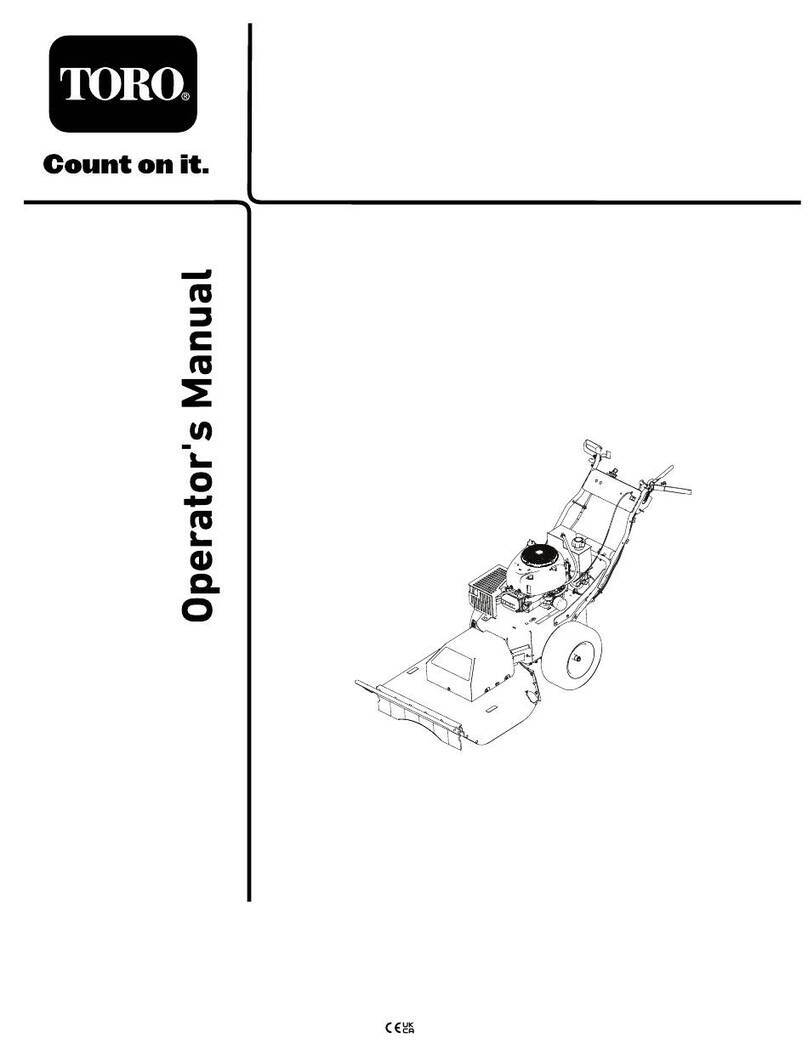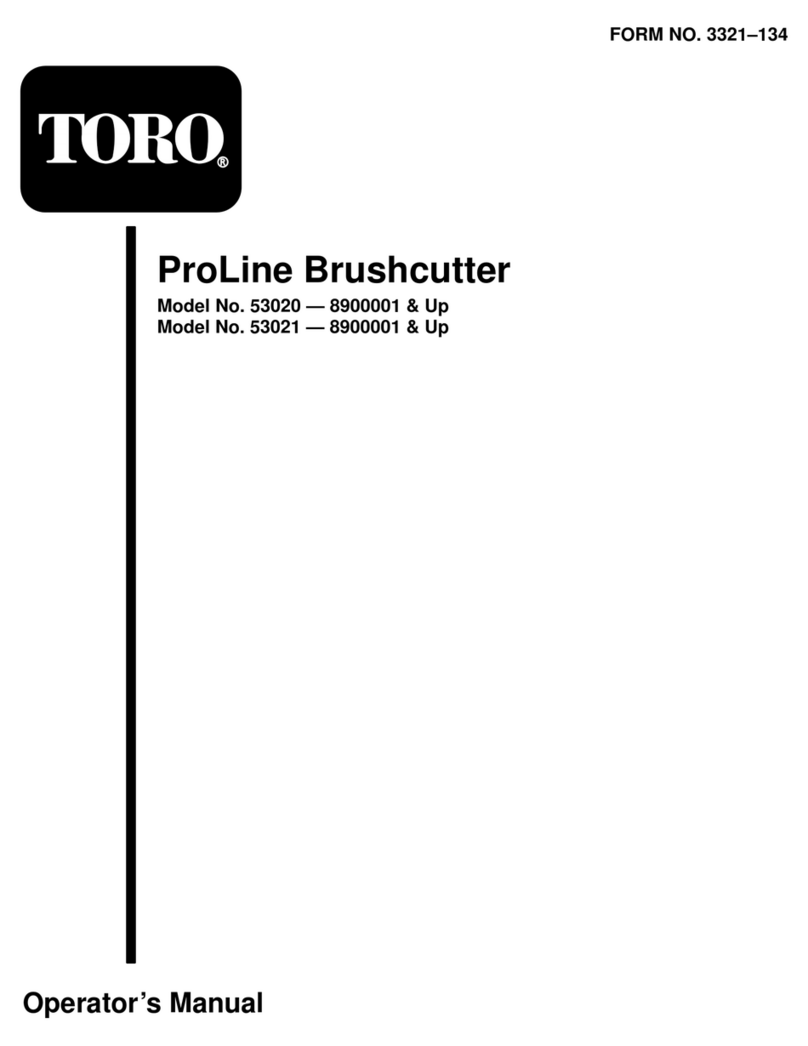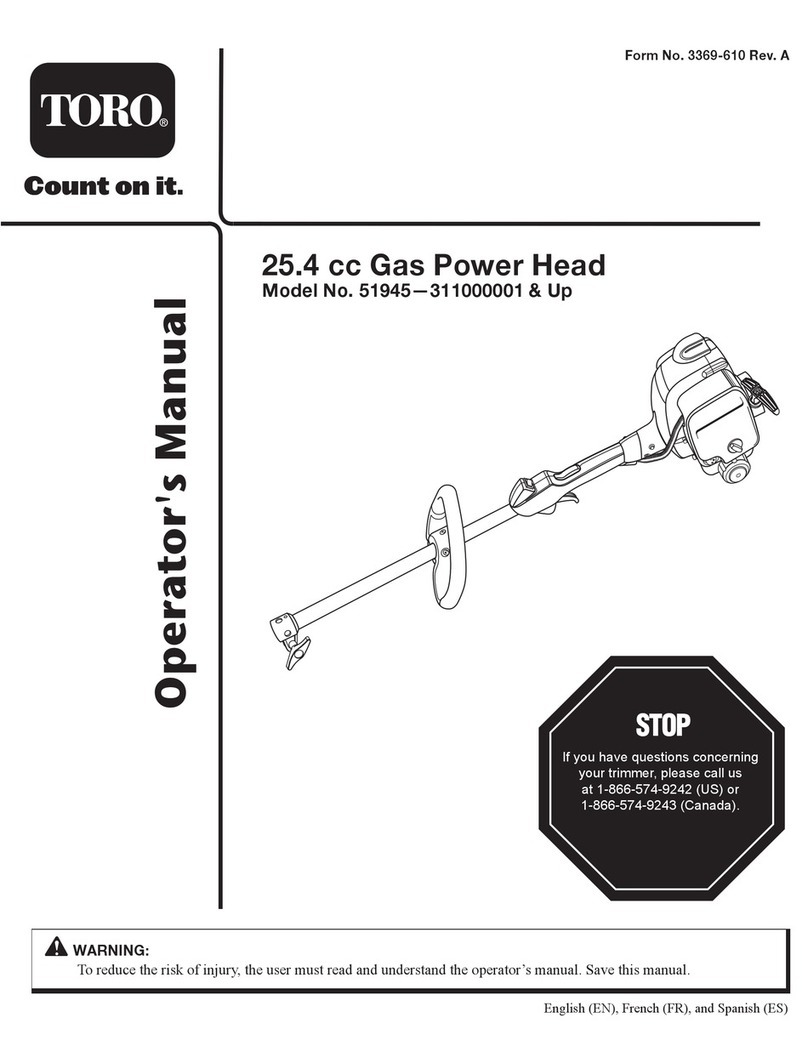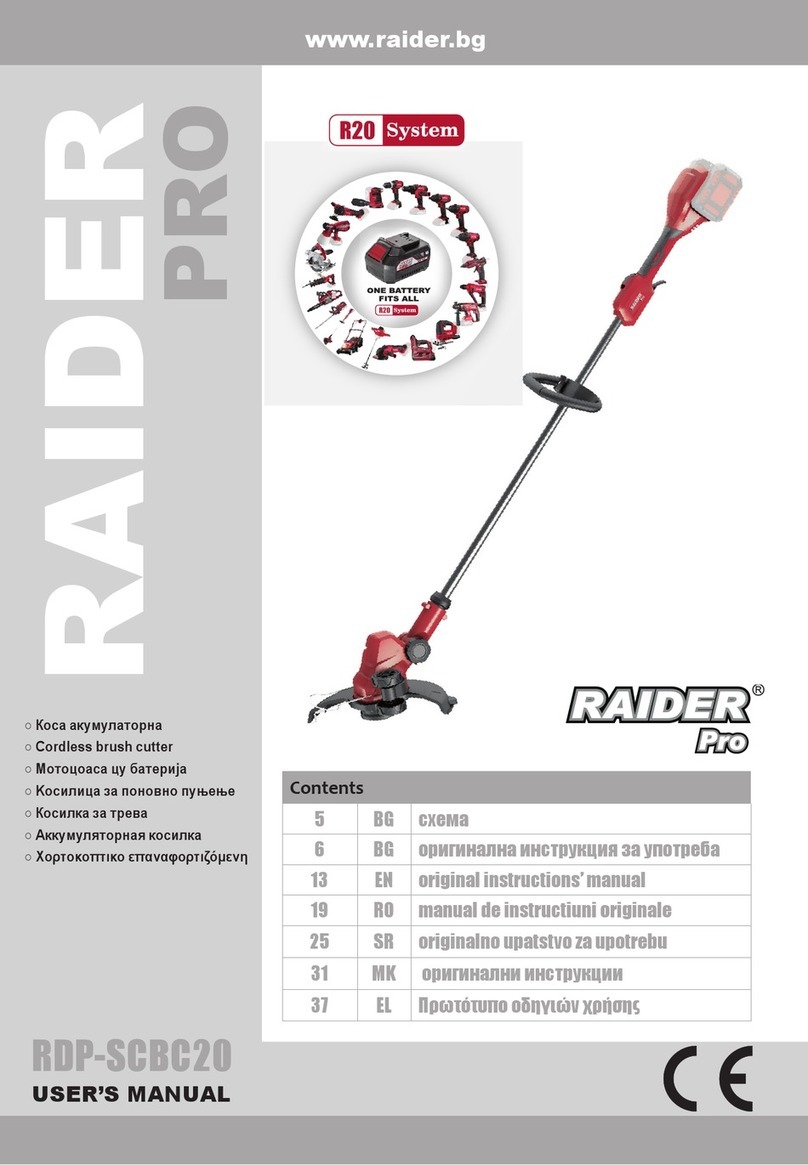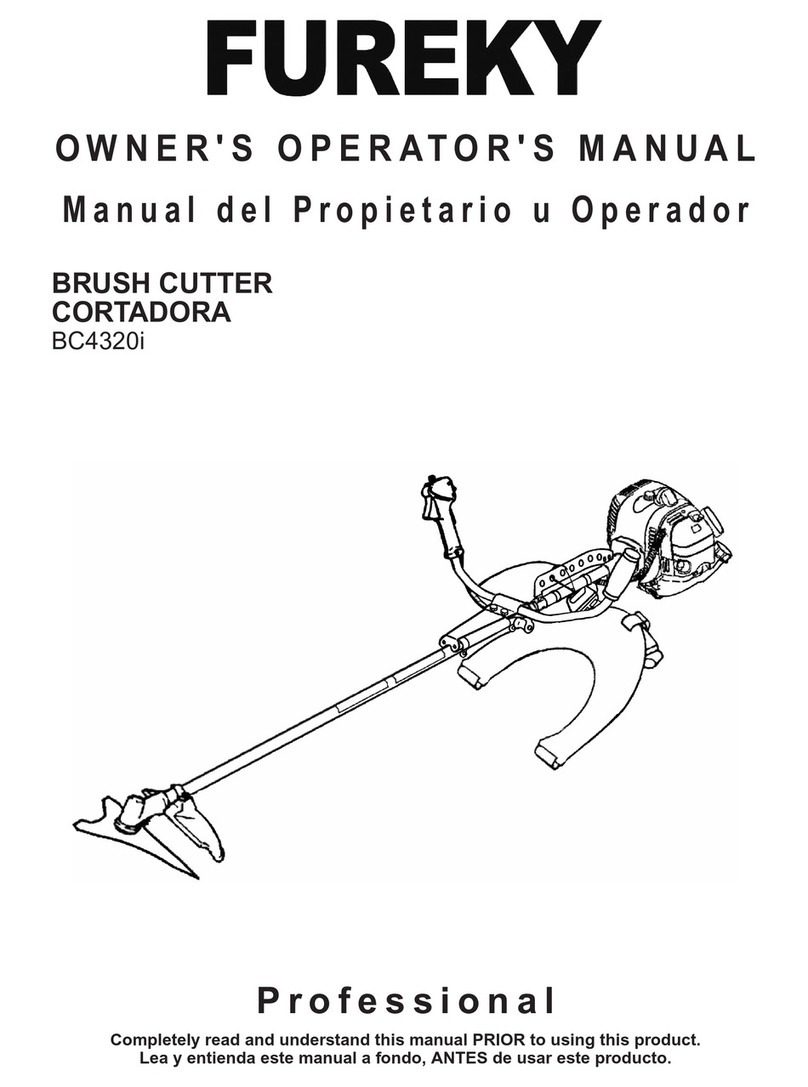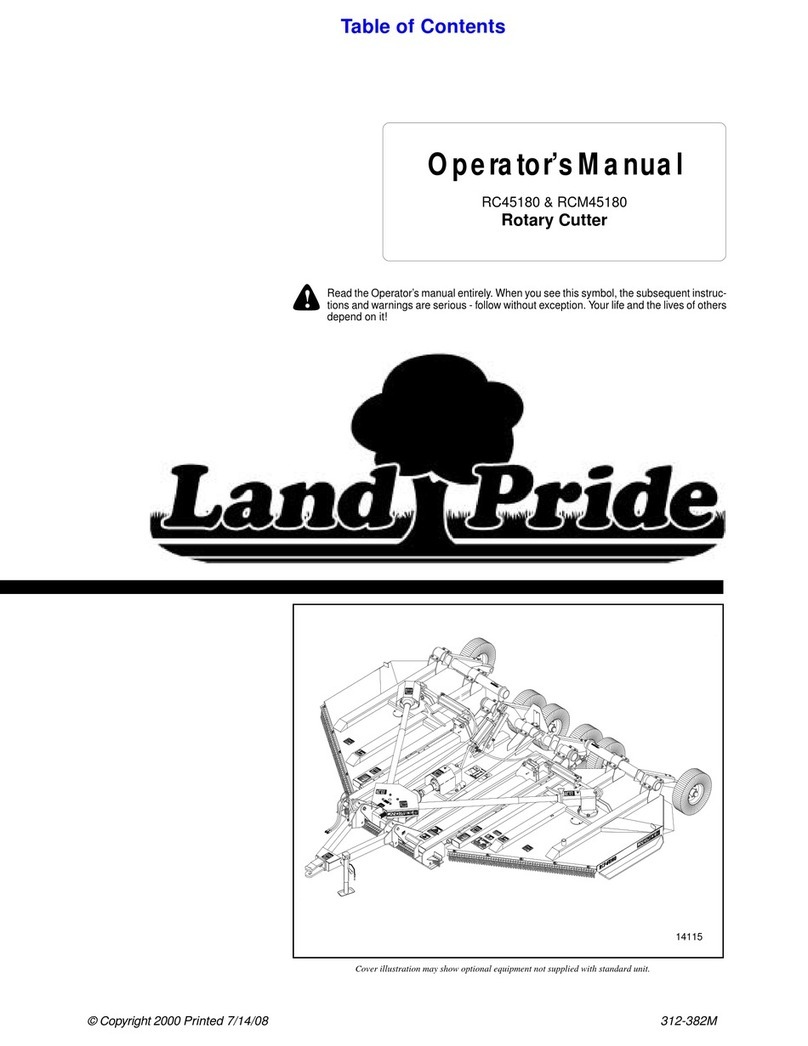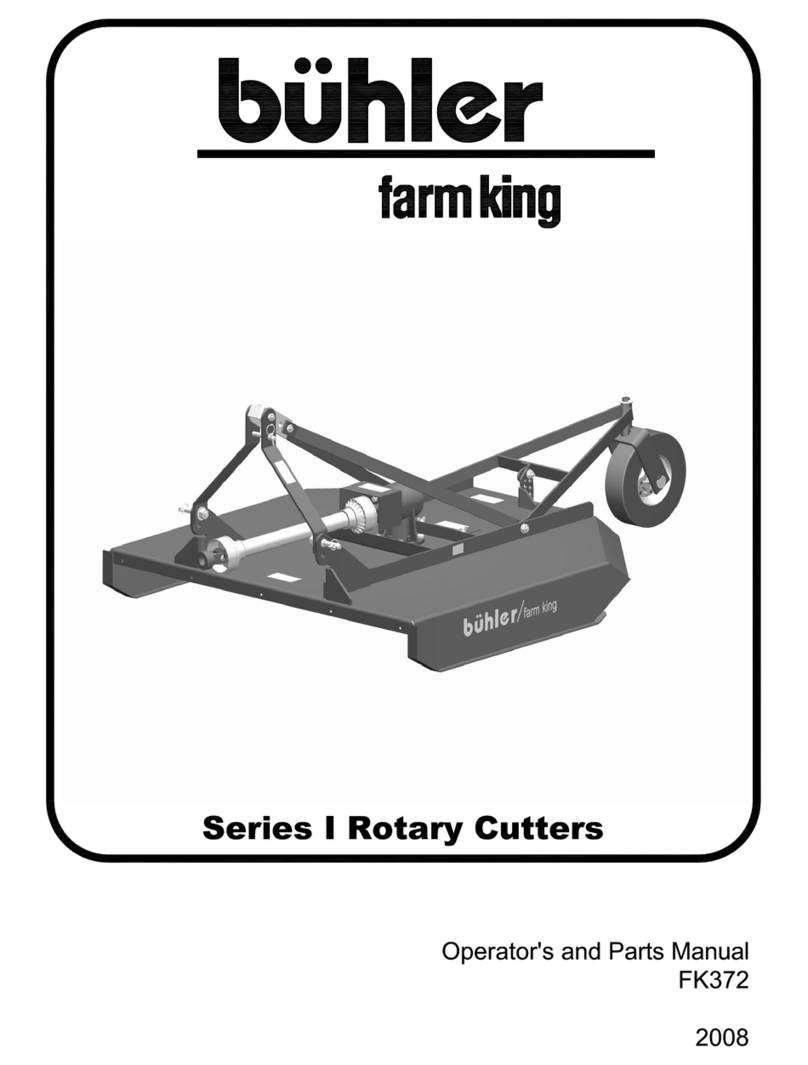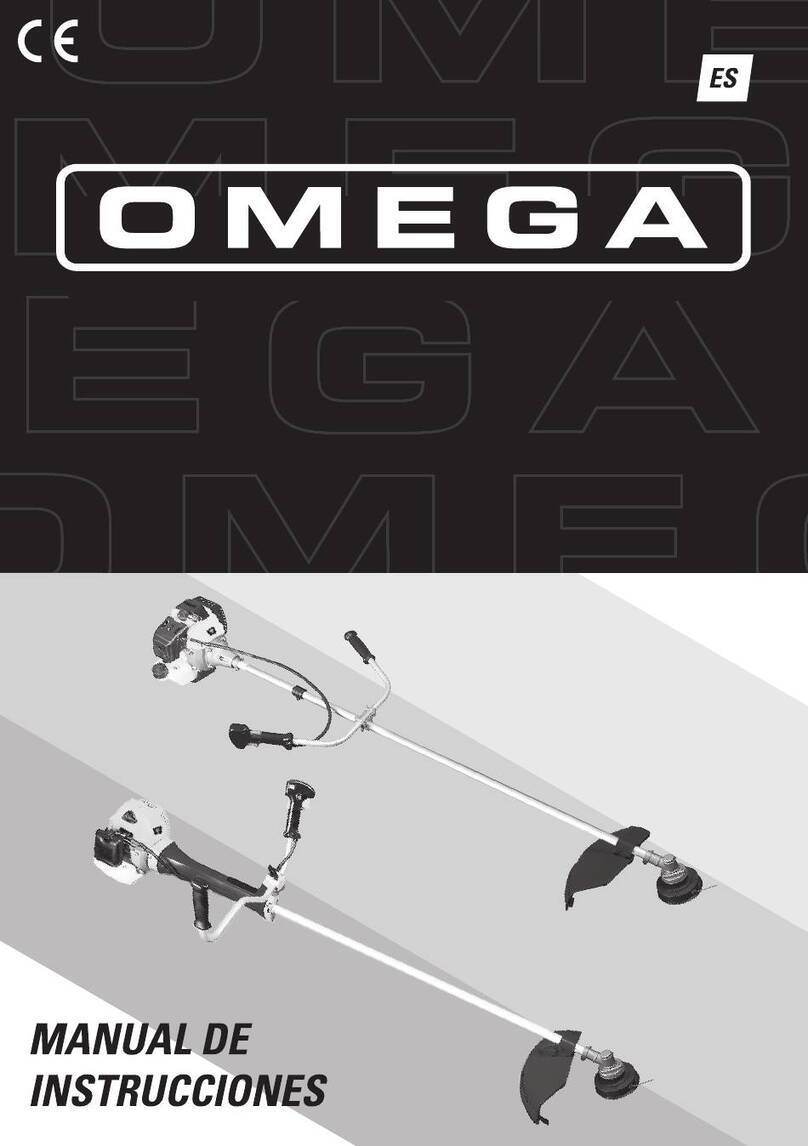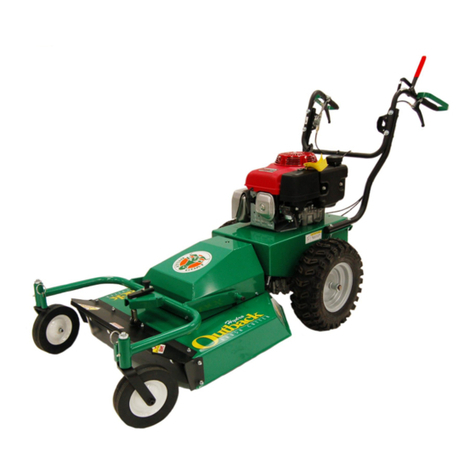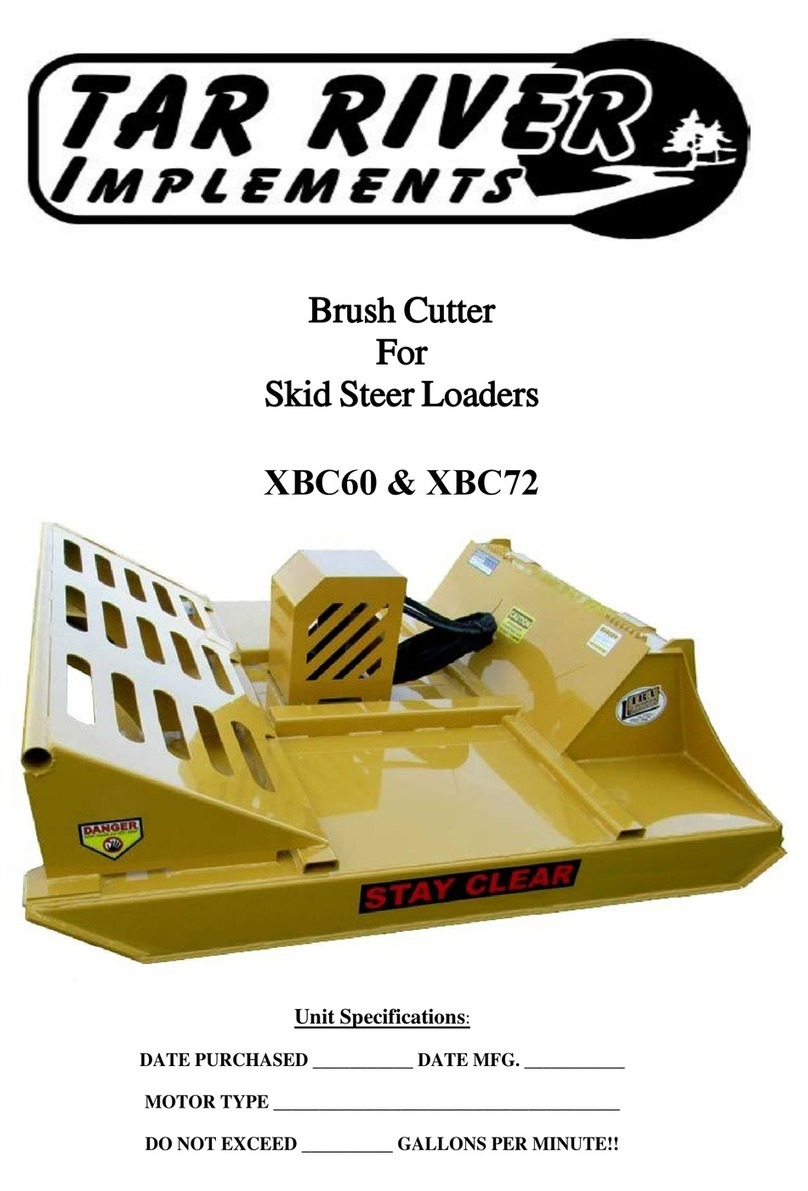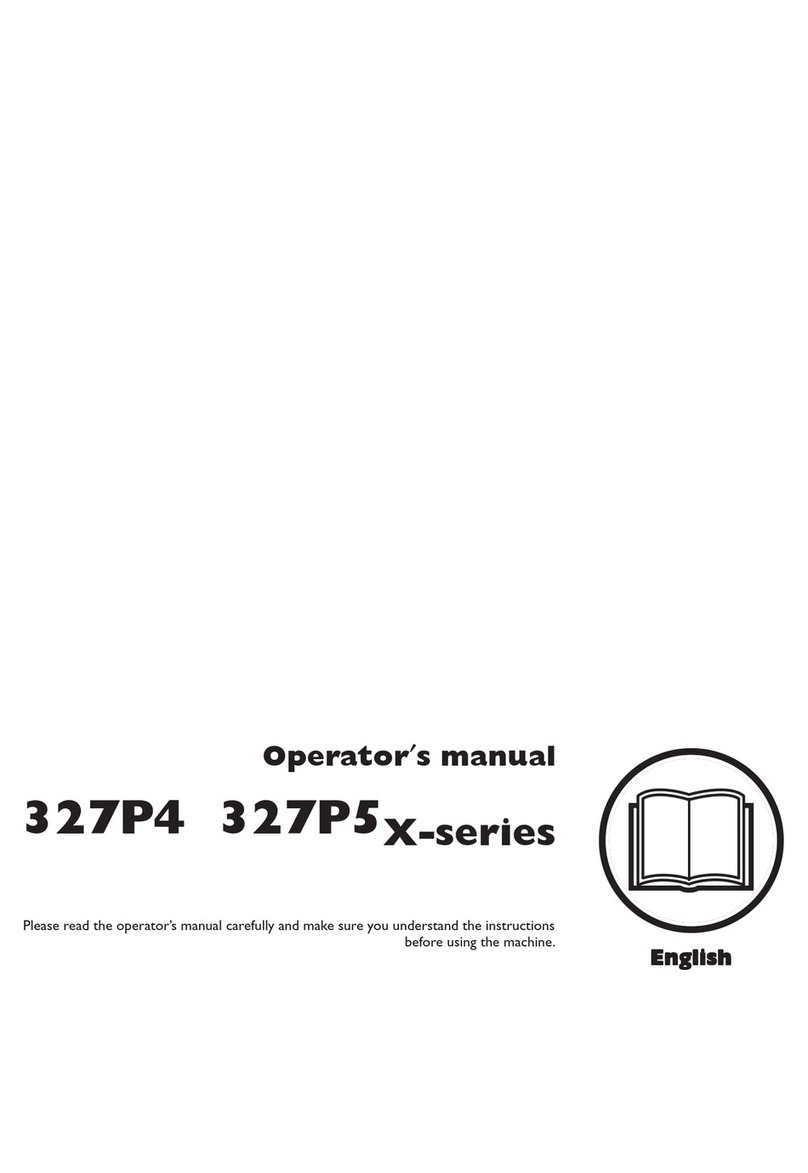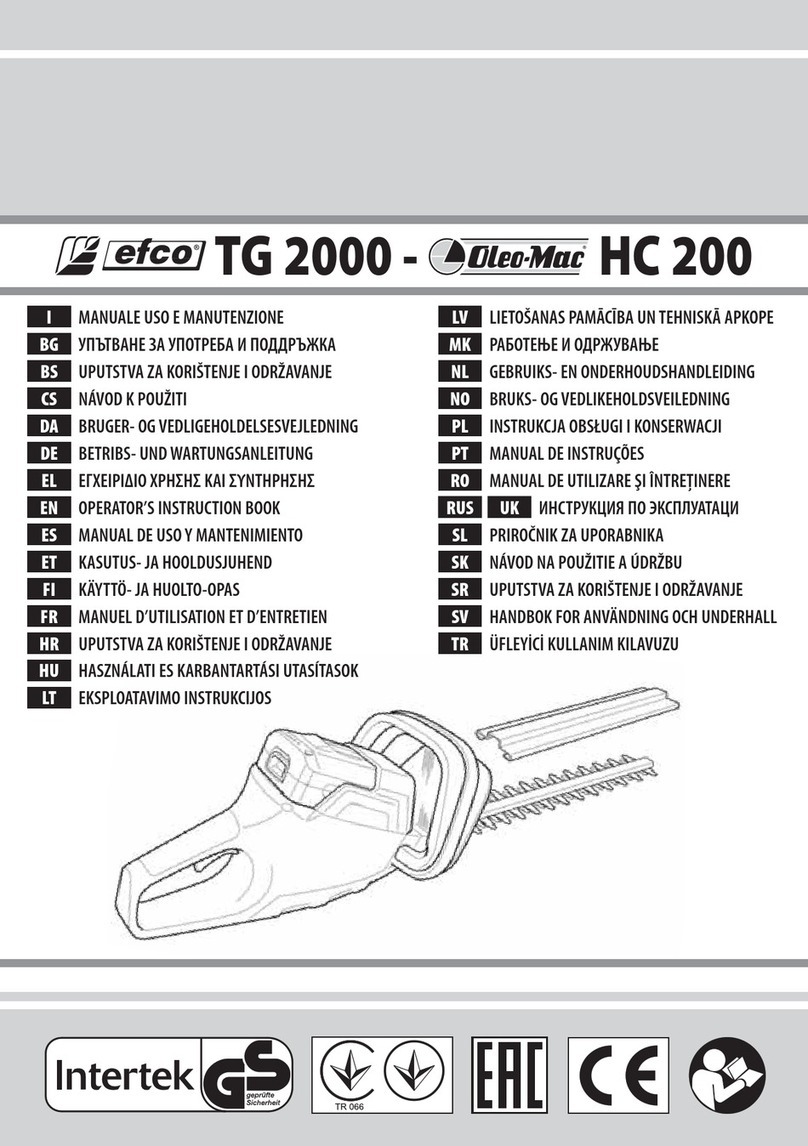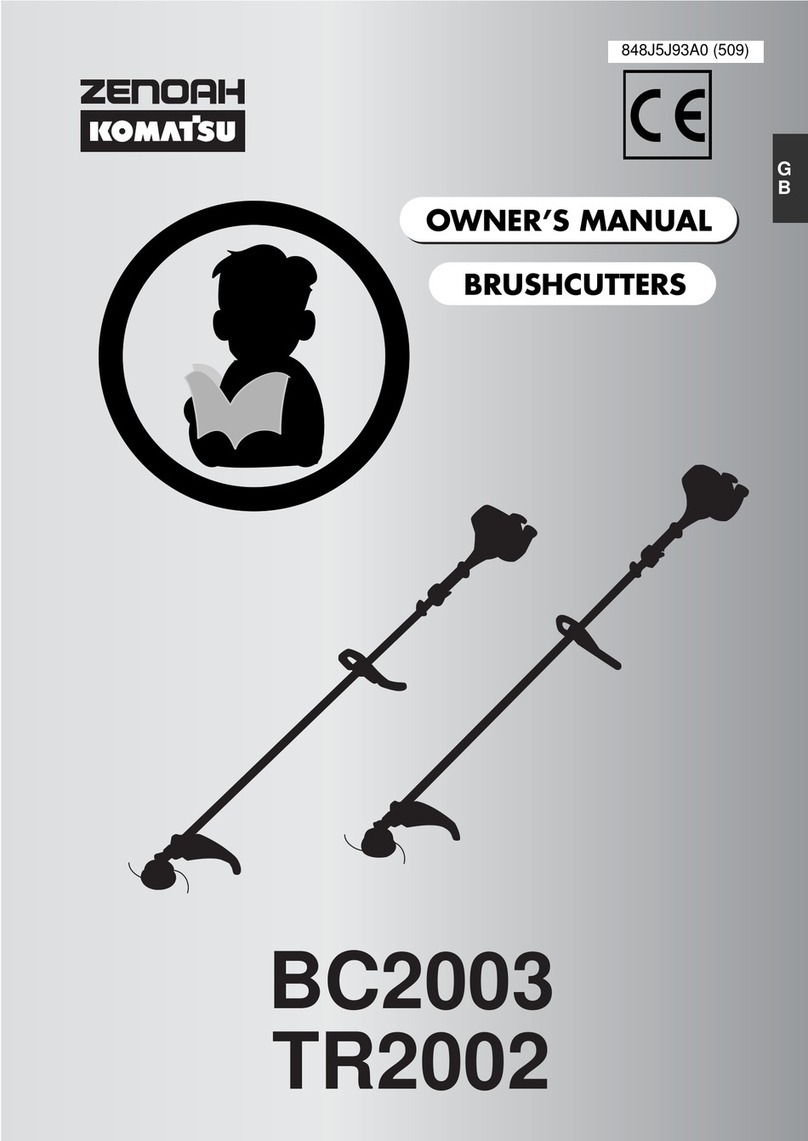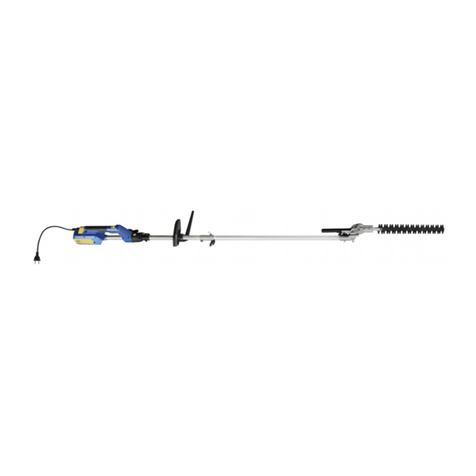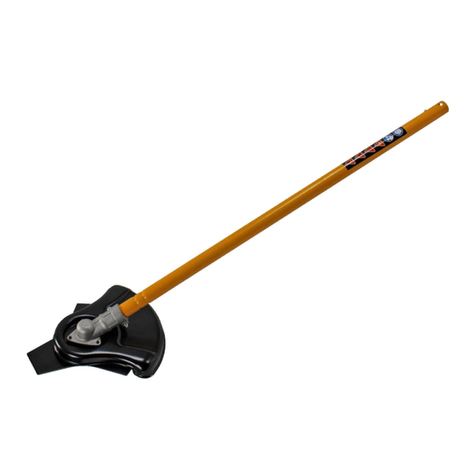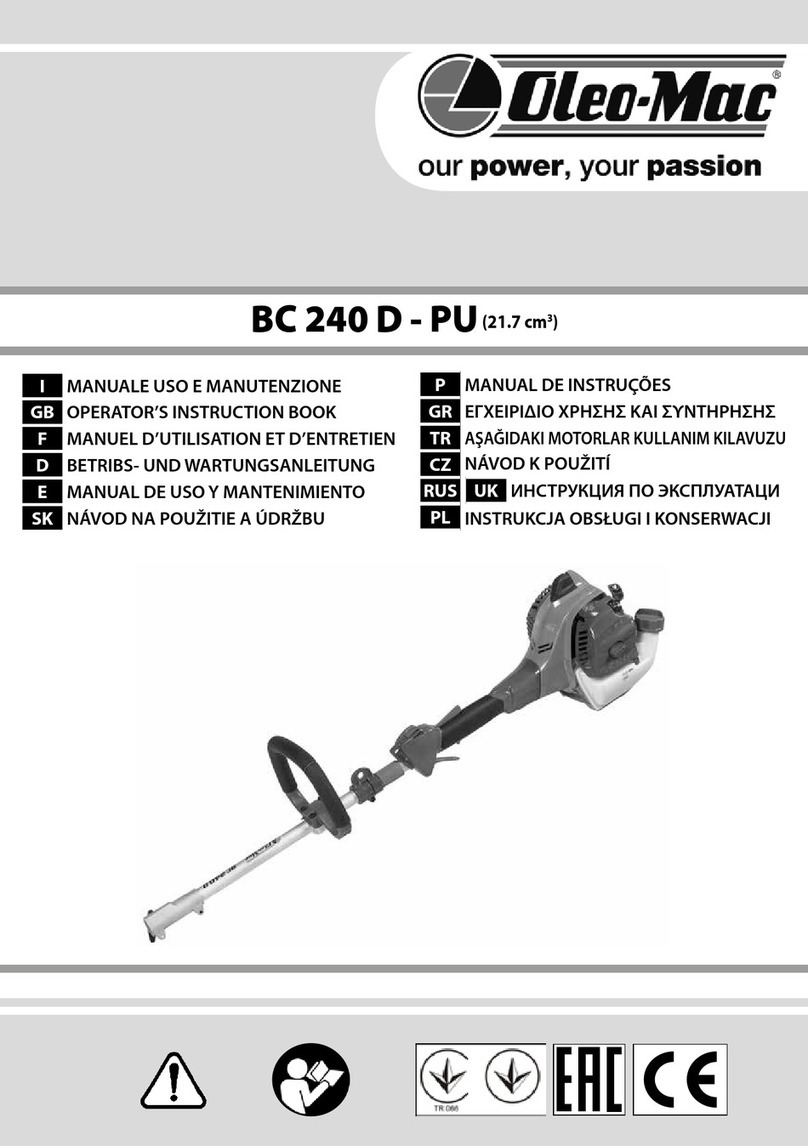Toro ProLine 53020 User manual

Operator’s Manual
Manuel de l’Utilisateur Manual del Usuario
FORM NO. 3322-369
ProLine Brushcutter
Model No. 53020 — 895001 & Up
Model No. 53021 — 895001 & Up
16” & 18” Gas
Modèle No. 51903 — 790000001 et suivants
Modèle No. 51904 — 790000001 et suivants
Modèle No. 51906 — 790000001 et suivants
Modèle No. 51907 — 790000001 et suivants
16” & 18” Gas
Modelos N. 51903 — 790000001 y siguientes
Modelos N. 51904 — 790000001 y siguientes
Modelos N. 51906 — 790000001 y siguientes
Modelos N. 51907 — 790000001 y siguientes


The Toro Company – 1998
All Rights Reserved
1
Contents
Page
Introduction 2. . . . . . . . . . . . . . . . . . . . . . . . . . . . . . . . .
Safety 3. . . . . . . . . . . . . . . . . . . . . . . . . . . . . . . . . . . . . .
Operator Safety 3. . . . . . . . . . . . . . . . . . . . . . . . . . .
Brushcutter Safety 3. . . . . . . . . . . . . . . . . . . . . . . . .
Fuel Safety 3. . . . . . . . . . . . . . . . . . . . . . . . . . . . . . .
Power Brushcutter Operating Safety 4. . . . . . . . . . .
Safety and Instruction Decals 5. . . . . . . . . . . . . . . . . . .
Assembly 6. . . . . . . . . . . . . . . . . . . . . . . . . . . . . . . . . . .
Bullhorn Handle Installation 6. . . . . . . . . . . . . . . . .
Installing Shield 6. . . . . . . . . . . . . . . . . . . . . . . . . . .
Installing Brushcutter Blade 7. . . . . . . . . . . . . . . . . .
Attaching Strap 8. . . . . . . . . . . . . . . . . . . . . . . . . . .
Installing Brushcutter Blade Cover 8. . . . . . . . . . . .
Before Operation 9. . . . . . . . . . . . . . . . . . . . . . . . . . . . .
Oil and Fuel 9. . . . . . . . . . . . . . . . . . . . . . . . . . . . . .
Mixing Gasoline And Oil 10. . . . . . . . . . . . . . . . . . . .
Starting And Stopping 11. . . . . . . . . . . . . . . . . . . . . .
Hot Restart 12. . . . . . . . . . . . . . . . . . . . . . . . . . . . . . .
Page
Operation 12. . . . . . . . . . . . . . . . . . . . . . . . . . . . . . . . . . .
Operating Position 12. . . . . . . . . . . . . . . . . . . . . . . . .
Cutting Direction 13. . . . . . . . . . . . . . . . . . . . . . . . . .
Cutting Blades 13. . . . . . . . . . . . . . . . . . . . . . . . . . . .
Maintenance 14. . . . . . . . . . . . . . . . . . . . . . . . . . . . . . . . .
Air Filter 14. . . . . . . . . . . . . . . . . . . . . . . . . . . . . . . . .
Spark Plug 15. . . . . . . . . . . . . . . . . . . . . . . . . . . . . . .
Fuel Filter 15. . . . . . . . . . . . . . . . . . . . . . . . . . . . . . . .
Idle Speed Adjustment 16. . . . . . . . . . . . . . . . . . . . . .
Cylinder Cooling Fins 16. . . . . . . . . . . . . . . . . . . . . .
Spark Arrester 17. . . . . . . . . . . . . . . . . . . . . . . . . . . .
Exhaust Muffler 17. . . . . . . . . . . . . . . . . . . . . . . . . . .
Gearcase Maintenance 18. . . . . . . . . . . . . . . . . . . . . .
General Cleaning and Tightening 18. . . . . . . . . . . . .
Blade Sharpening 18. . . . . . . . . . . . . . . . . . . . . . . . . .
Storage 19. . . . . . . . . . . . . . . . . . . . . . . . . . . . . . . . . . . . .
Accessories 20. . . . . . . . . . . . . . . . . . . . . . . . . . . . . . . . .
Troubleshooting 21. . . . . . . . . . . . . . . . . . . . . . . . . . . . . .
Specifications 22. . . . . . . . . . . . . . . . . . . . . . . . . . . . . . . .
Federal and California Emission Control
Warranty Statement 23. . . . . . . . . . . . . . . . . . . . . . . . . .
Warranty 26. . . . . . . . . . . . . . . . . . . . . . . . . . . . . . . . . . . .
The engine exhaust from this product
contains chemicals known to the State of
California to cause cancer, birth defects,
or other reproductive harm.
WARNING:

2
Introduction
Thank you for purchasing a Toro product.
All of us at Toro want you to be completely satisfied with
your new product, so feel free to contact your local
Authorized Service Dealer for help with service, genuine
Toro parts, or other information you may require.
Whenever you contact your Authorized Service Dealer or
the factory, always know the model and serial numbers of
your product. These numbers will help the Service Dealer
or Service Representative provide exact information about
your specific product. You will find the model and serial
number decal located in a unique place on the product
(Fig. 1).
Figure 1
1. Gearcase
2. Shaft Assembly
3. Throttle Trigger and Stop
Switch
4. Bullhorn Handle
5. Shoulder Harness
Attachment
6. Shaft Grip
7. Clutch Drum Housing
8. Engine
9. Model and Serial Number
Decal (on rear of engine
stand)
10. Brushcutter Blade
11. Blade Shield
12. Strap
13. Throttle Cable and Stop
Switch Wires
14. Fuel Tank
15. Air Filter
For your convenience, write the product model and serial
numbers in the space below.
Model No.
Serial No.
Read this manual carefully to learn how to operate and
maintain your product correctly. Reading this manual will
help you and others avoid personal injury and damage to
the product. Although Toro designs, produces and markets
safe, state-of-the-art products, you are responsible for
using the product properly and safely. You are also
responsible for training persons who you allow to use the
product about safe operation.
The Toro warning system in this manual identifies
potential hazards and has special safety messages that help
you and others avoid personal injury, even death.
DANGER, WARNING and CAUTION are signal words
used to identify the level of hazard. However, regardless
of the hazard, be extremely careful.
DANGER signals an extreme hazard that will cause
serious injury or death if the recommended precautions
are not followed.
WARNING signals a hazard that may cause serious injury
or death if the recommended precautions are not followed.
CAUTION signals a hazard that may cause minor or
moderate injury if the recommended precautions are not
followed. Two other words are also used to highlight
information. “Important” calls attention to special
mechanical information and “Note” emphasizes general
information worthy of special attention.

3
Safety
Operator Safety
1. Read and understand this Operator’s Manual before
using this product. Be thoroughly familiar with the
proper use of this product.
2. Never allow children to operate the Brushcutter. It is
not a toy. Never allow adults to operate the unit
without first reading the Operator’s Manual.
3. Always wear eye protection that complies with ANSI
(American National Standards Institute) Z87–1.
4. Always wear hearing protection.
5. Always wear heavy, long pants, a long sleeved shirt,
boots and gloves. Do not wear loose clothing, jewelry,
short pants, sandals, or go barefoot. Secure hair so it is
above shoulder length.
6. Never operate this Brushcutter when you are tired, ill,
or under the influence of alcohol, drugs or medication.
7. Never start or run the engine inside a closed room or
building. Breathing exhaust fumes can cause death.
8. Keep handles clean of oil, fuel and dirt.
Brushcutter Safety
1. Make sure the Brushcutter is assembled correctly and
that the Brushcutter blade is correctly installed and
securely fastened as instructed in the Assembly
section.
2. Inspect the Brushcutter before each use. Replace
damaged parts. Check for fuel leaks. Make sure all
fasteners are in place and tightened securely. Follow
the maintenance instructions beginning on page 14.
3. Make sure the Brushcutter blade does not rotate at
engine idle speed. Refer to Idle Speed Adjustment,
page 16.
4. Inspect the Brushcutter cutting blade and replace any
parts that are cracked, chipped or damaged before
using the Brushcutter.
5. Make sure the blade shield is installed and positioned
correctly before using the Brushcutter.
6. Never use a cutting blade or replacement parts that are
not approved by Toro.
7. Maintain the Brushcutter according to the
recommended maintenance intervals and procedures in
the Maintenance section on page 14.
8. Shut off the engine and be certain the cutting blade has
completely stopped rotating before inverting the
Brushcutter, performing maintenance on or working on
the machine.
9. If running problems or excessive vibration occur, stop
immediately and inspect the unit for the cause. If the
cause cannot be determined or is beyond your ability
to correct, return the Brushcutter to your servicing
dealer for repair.
Fuel Safety
1. Gasoline is highly flammable and must be handled and
stored carefully. Use a container approved for fuel for
storing gasoline and/or fuel/oil mixture.
2. Mix and pour fuel outdoors and where there are no
sparks or flames.
3. Do not smoke near fuel or Brushcutter, or while using
the Brushcutter.
4. Do not overfill the fuel tank. Stop filling 1/4–1/2 inch
(6mm–13mm) from the top of the tank.
5. Wipe up any spilled fuel before starting the engine.

4
6. Move the Brushcutter at least 10 feet (3 m) away from
the fueling location before starting the engine (Fig. 2).
m-3021
Figure 2
1. 10 feet (3m) Minimum
7. Do not remove the Brushcutter fuel tank cap while the
engine is running, or right after stopping the engine.
8. Allow the engine to cool before refueling.
9. Drain the tank and run the engine dry before storing
the unit.
10.Store fuel and Brushcutter away from open flame,
sparks and excessive heat. Make sure fuel vapors
cannot reach sparks or open flames from water heaters,
furnaces, electric motors, etc.
Power Brushcutter Operating
Safety
1. THIS BRUSHCUTTER CAN CAUSE SERIOUS
INJURIES. Read the instructions carefully. Be familiar
with all controls and the proper use of the Brushcutter.
2. Make sure the 3mm hex wrench has been removed
from the gearcase and boss adapter before you start the
engine (Fig 6).
3. Avoid using the Brushcutter near rocks, gravel, stones
and similar material that would cause harmful
missiles.
4. Keep children, bystanders and animals outside a 50 ft.
(15 m) radius from the operator and Brushcutter
(Fig. 3).
m-2967
Figure 3
1. 50 ft. (15 m) Minimum
5. If you are approached while operating the Brushcutter,
stop the engine and Brushcutter blade rotation.
6. Use the Brushcutter only in daylight or good artificial
light.
7. Never operate the Brushcutter without proper guards
or other protective safety devices in place.
8. Do not put hands or feet near or under any rotating
parts. Keep clear at all times. Keep all parts of your
body away from the rotating Brushcutter blade and hot
surfaces such as the muffler.
9. When cutting heavy brush or small trees, always swing
the Brushcutter from right to left to prevent kick-back
(Figs 12 and 13).
10.Keep firm footing and balance. Do not overreach.
11. Use the right tool for the job. Do not use the
Brushcutter for any job that is not recommended by
Toro.

5
Safety and Instruction Decals
Safety decals and instructions are easily visible to the operator and are located near any
area of potential danger. Replace any decal that is damaged or lost.
ON SHAFT
(Part No. M221501)
ON SHAFT
(Part No. M221502)
ON ENGINE
(Part No. M266291)

6
Assembly
Bullhorn Handle Installation
IMPORTANT: Be careful not to damage the throttle
cable and stop switch wires when you remove the
bullhorn handles from the shipping carton.
1. Loosen the four Phillips hex head screws on the top of
the clamp bracket (Fig. 4).
2. Insert the left and right bullhorn handles into the
clamp bracket. Note that the bullhorn handle with the
throttle trigger and stop switch goes on the right-hand
side of the Brushcutter (Fig. 4).
3. Adjust the bullhorn handles to the desired position,
then tighten the four Phillips hex head screws (Fig. 4).
m-3022
Figure 4
1. Throttle Trigger/Stop
Switch
2. StopSwitchWires/Throttle
Cable
3. Clamp Bracket
4. Screw (4)
5. Bullhorn Handle (2)
Installing Shield
POTENTIAL HAZARD
•Foreign objects can be thrown by Brushcutter.
WHAT CAN HAPPEN
•Contact with thrown objects can cause personal
injury.
HOW TO AVOID THE HAZARD
•Never operate the Brushcutter without the
blade shield in place.
1. Install the blade shield onto the gearcase (Fig. 5).
2. Install and tighten the four M5 x 12 screws (Fig. 5).
m-2990
Figure 5
1. Gearcase
2. Blade Shield 3. M5 x 12 Screw (4)

7
Installing Brushcutter Blade
POTENTIAL HAZARD
•If the Brushcutter blade is not adequately
tightened, it can come loose from the
Brushcutter during use.
WHAT CAN HAPPEN
•This may cause damage to property or personal
injury.
HOW TO AVOID THE HAZARD
•Make sure the Brushcutter blade is securely
fastened to the splined shaft in the gearcase.
1. Remove the blade bolt, stabilizer and clamping washer
from the splined shaft out of the gearcase (Fig. 6).
Note: The blade bolt has left-hand threads.
POTENTIAL HAZARD
•Brushcutter blade is sharp.
WHAT CAN HAPPEN
•Contact with sharp blade can cause serious
personal injury.
HOW TO AVOID THE HAZARD
•Wear gloves when you handle the blade.
2. Install the brushcutter blade onto the boss adapter, then
reinstall the clamping washer, stabilizer and blade bolt
(Fig. 6).
3. Align the hole in the boss adapter with the hole in the
gearcase (Fig. 6).
4. Insert a 3mm hex wrench or other suitable tool into the
holes in the boss adapter and gearcase to lock the
splined shaft (Fig. 6).
5. Tighten blade bolt to 100 in.-lbs. (11.3 NSM) (Fig. 6).
6. Remove the 3mm hex wrench from the boss adapter
and gearcase (Fig. 6).
m-2984
Figure 6
1. Gearcase
2. 3mm Hex Wrench
3. Splined Shaft
4. Boss Adapter
5. Edger Blade (eight-tooth)
6. Clamping Washer
7. Stabilizer
8. Blade Bolt (left-hand
thread)

8
Attaching Strap
POTENTIAL HAZARD
•Without the strap installed on the Brushcutter,
the blade can produce side thrust which can
expose the operator and bystanders to blade
contact.
WHAT CAN HAPPEN
•Contact with the Brushcutter blade can cause
severe personal injury.
HOW TO AVOID THE HAZARD
•Never operate the Brushcutter without
installing and using the strap.
Snap the strap hook into the ring on the drive shaft. To
detach the strap quickly from the Brushcutter, pull upward
on the red band (Fig. NO TAG).
m-2991
Figure 7
1. Red Band
2. Strap 3. Ring
Installing Brushcutter Blade
Cover
POTENTIAL HAZARD
•Brushcutter blade is sharp.
WHAT CAN HAPPEN
•Contact with sharp blade can cause serious
personal injury.
•An unprotected blade is subject to damage.
HOW TO AVOID THE HAZARD
•Keep the blade cover on the blade when the
Brushcutter is not in use. This will protect
persons from injury from blade contact, and
will protect the blade from damage.
1. Insert the tips of the blade into the grooves in the blade
cover (Fig. 8).
2. Wind the cover around the blade, then snap the hook
to secure the blade cover (Fig. 8).
m-3025
Figure 8
1. Brushcutter Blade
2. Groove 3. Blade Cover
4. Hook

9
Before Operation
Oil and Fuel
POTENTIAL HAZARD
•In certain conditions gasoline is extremely
flammable and highly explosive.
WHAT CAN HAPPEN
•A fire or explosion from gasoline can burn you,
others, and cause property damage.
HOW TO AVOID THE HAZARD
•Use a funnel and fill the fuel tank outdoors, in
an open area, when the engine is cold. Wipe up
any gasoline that spills.
•Do not fill the fuel tank completely full. Add
gasoline to the fuel tank until the level is 1/4” to
1/2” (6 mm to 13 mm) below the bottom of the
filler neck. This empty space in the tank allows
gasoline to expand.
•Never smoke when handling gasoline, and stay
away from an open flame or where gasoline
fumes may be ignited by a spark.
•Store gasoline in an approved container and
keep it out of the reach of children.
•Never buy more than a 30-day supply of
gasoline.
1. Do not smoke near fuel.
2. Mix and pour fuel outdoors and where there are no
sparks or flames.
3. Always shut off the engine before refueling. Never
remove the String Trimmer fuel tank cap while the
engine is running or right after just stopping the
engine.
POTENTIAL HAZARD
•Gasoline contains gasses that can build up
pressure inside a gas tank.
WHAT CAN HAPPEN
•Fuel can be sprayed on you when removing gas
cap.
HOW TO AVOID THE HAZARD
•Remove fuel cap slowly to avoid injury from
fuel spray.
4. Always open the fuel tank cap slowly to release any
possible overpressure inside the tank.
5. Do not overfill the fuel tank. Stop filling 1/4–1/2 inch
(6mm–13mm) from the top of the tank.
6. Tighten the tank fuel cap carefully but firmly after
refilling.
7. Wipe up any spilled fuel before starting the engine.
8. Move the String Trimmer at least 10 feet (3 m) away
from the fueling location and fuel storage container
before starting the engine (Fig. NO TAG).
Recommended Oil Type
Only use a two-cycle engine oil formulated for use in
high-performance, air-cooled two-cycle engines. Toro
brand 2-cycle oil is formulated for use in
high-performance, air-cooled two-cycle engines.
IMPORTANT: Do not use National Marine
Manufacturer’s Association (NMMA) or BIA certified
oils. This type of 2–cycle engine oil does not have the
proper additives for air-cooled, 2–cycle engines and
can cause engine damage.
Do not use automotive motor oil. This type of
oil does not have the proper additives for
air-cooled, 2–cycle engines and can cause
engine damage.
Recommended Fuel Type
Use clean, fresh lead-free gasoline, including oxygenated
or reformulated gasoline, with an octane rating of 85 or
higher. To ensure freshness, purchase only the quantity of
gasoline that can be used in 30 days. Use of lead-free
gasoline results in fewer combustion chamber deposits
and longer spark plug life. Use of premium grade fuel is
not necessary or recommended.
Use Of Fuel Additives
IMPORTANT: NEVER USE METHANOL,
GASOLINE CONTAINING METHANOL,
GASOHOL CONTAINING MORE THAN
10% ETHANOL, PREMIUM GASOLINE,
OR WHITE GAS BECAUSE ENGINE
FUEL SYSTEM DAMAGE COULD
RESULT.
DO NOT USE FUEL ADDITIVES OTHER
THAN THOSE MANUFACTURED FOR
FUEL STABILIZATION DURING
STORAGE SUCH AS TORO’S

10
STABILIZER/CONDITIONER OR A
SIMILAR PRODUCT. TORO’S
STABILIZER/CONDITIONER IS A
PETROLEUM DISTILLATE BASED
CONDITIONER/STABILIZER.
TORO DOES NOT RECOMMEND
STABILIZERS WITH AN ALCOHOL BASE
SUCH AS ETHANOL, METHANOL OR
ISOPROPYL. ADDITIVES SHOULD NOT
BE USED TO TRY TO ENHANCE THE
POWER OR PERFORMANCE OF
MACHINE.
Mixing Gasoline And Oil
IMPORTANT: The engine used on this String Trimmer
is of a 2–cycle design. The internal moving parts of the
engine, i.e., crankshaft bearings, piston pin bearings
and piston to cylinder wall contact surfaces, require oil
mixed with the gasoline for lubrication.
Failure to add oil to the gasoline or failure to
mix oil with the gasoline at the appropriate
ratio will cause major engine damage which
will void your warranty.
For your fuel premix, only use a quality oil
designed for 2–cycle air cooled engines. Toro
50:1 2–Cycle Oil is formulated to meet the
requirements of high-performance, air-cooled
two-cycle engines.
Fuel Mixture
The fuel:oil ratio is 50 parts gasoline to 1 part oil or 50:1.
Note: Never use a mixing ratio less than 50:1
regardless of the oil package mixing instructions.
Ratios less the 50:1, (for example, 60:1, 80:1, 100:1),
reduce the amount of lubrication to the internal
moving parts of the engine and can cause damage.
Fuel Mixture Chart
Gasoline 50:1 2-cycle oil
1 gallon 2.6 oz.
2 gallons 5.2 oz.
5 gallons 12.8 oz.
Mixing Instructions
IMPORTANT: Never mix gasoline and oil directly in
the String Trimmer fuel tank.
1. Always mix fuel and oil in a clean container approved
for gasoline.
2. Mark the container to identify it as fuel mix for the
String Trimmer.
3. Use regular unleaded gasoline and fill the container
with half the required amount of gasoline.
4. Pour the correct amount of oil into the container then
add the remaining amount of gasoline.
5. Close the container tightly and shake it momentarily to
evenly mix the oil and the gasoline before filling the
fuel tank on the String Trimmer.
6. When refilling the String Trimmer fuel tank, clean
around the fuel tank cap to prevent dirt and debris
from entering the tank during cap removal.
7. Always shake the premix fuel container momentarily
before filling the fuel tank
8. Always use a spout or funnel when fueling to reduce
fuel spillage.
9. Fill the tank only to within 1/4–1/2 inch (6mm–13mm)
from the top of the tank. Avoid filling to the top of the
tank filler neck.

11
Starting And Stopping
Before Starting The Engine
1. Fill the fuel tank as instructed in the Before Operation
section of this manual.
2. Rest the String Trimmer on the ground.
3. Make sure the trimmer head is clear of any broken
glass, nails, wire, rocks or other debris.
4. Keep all bystanders, children and animals away from
the working area.
Cold Starting Procedure
The carburetors on Toro engines contain a choke system.
To start a “cold” engine properly, perform the following
procedure:
1. Pump the primer bulb at the bottom of the carburetor
until fuel can be seen flowing through the fuel return
line to the fuel tank (Figs. 9). (Flowing fuel should be
almost clear, not foamy or full of bubbles.)
m-2978
Figure 9
1. Primer Bulb 2. Fuel Return Line
2. Move the choke lever to the closed ( ) position and
move the stop switch to the “ON” position (Figs. 10
and 11).
m-2938
Figure 10
1. Starter Handle 2. Choke Lever (typical)
3. Lock the throttle trigger in the fast-idle start position,
then pull the starter handle (Figs. 11 and 10).
m-2939
Figure 11
1. Stop Switch
2. Fast-idle Lock
3. Throttle Trigger (in
fast-idle start position)
4. Throttle Trigger (in idle
position)
4. After the engine starts, move the choke lever to the
open ( ) position, then squeeze and release the
throttle trigger to allow it to return to the idle position
(Figs. 10 and 11).
If the engine stops running before you move the choke
lever to the open ( ) position:
A. Go ahead and open the choke (Fig. 10).
B. Make sure the throttle trigger is set to the fast-idle
start position (Fig. 11).
C. Pull the starter handle until the engine starts
(Fig. 10).

12
Hot Restart
To start an engine that is already warmed up (hot restart),
or if the ambient temperature exceeds 68_F (20_C):
1. Pump the primer bulb at the bottom of the carburetor
until fuel can be seen flowing through the fuel return
line to the fuel tank (Figs. 9).
2. Move the choke lever to the open ( ) position and
move the stop switch to the “ON” position (Figs. 10
and 11).
3. Leave the throttle trigger in the idle position and pull
the starter handle (Figs. 11 and 10).
4. If the engine fails to start after three to four pulls,
follow the instructions in the Cold Starting Procedure
section above.
If the engine fails to start after you follow the above
procedures, contact an authorized Toro dealer.
To Stop The Engine:
1. Release the throttle trigger (Fig. 11).
2. Slide the stop switch to the “STOP”position (Fig. 11).
Operation
POTENTIAL HAZARD
•Foreign objects can be thrown by Brushcutter.
WHAT CAN HAPPEN
•Contact with thrown objects can cause personal
injury.
HOW TO AVOID THE HAZARD
•Never operate the Brushcutter without the
blade shield in place.
•Read the Safety instructions on page NO TAG
concerning proper use of the Brushcutter.
Operating Position
Before using the Brushcutter, check the following:
1. Make sure the 3mm hex wrench has been removed
from the gearcase and boss adapter before you start the
engine (Fig 6).
2. The operator must be wearing the strap attached to the
Brushcutter, and the Brushcutter must be on the
operator’s right side.
3. The operator’s right hand should be holding the
right-hand bullhorn grip, with his or her fingers on the
throttle trigger.
4. The left hand should be holding the left-hand bullhorn
grip with the fingers and thumb fully enclosed around
the grip.
5. Always release the throttle trigger and allow the
engine to return to idle speed when not cutting.
6. Stop the Brushcutter engine when moving between
work sites.
POTENTIAL HAZARD
•Without the strap installed, the Brushcutter
blade can produce side thrust which can expose
the operator and bystanders to blade contact.
•If the Brushcutter is not correctly positioned on
the operator’s right side, the blade can produce
side thrust which can expose the operator and
bystanders to blade contact.
WHAT CAN HAPPEN
•Contact with the Brushcutter blade can cause
severe personal injury.
HOW TO AVOID THE HAZARD
•Never operate the Brushcutter without
installing and using the strap.
•Always operate the Brushcutter with the unit
on your right side.
•Always wear gloves and protective clothing
when operating the Brushcutter.
•If the Brushcutter blade becomes jammed, stop the
engine immediately.
•Make certain all moving parts have stopped and
disconnect the spark plug before inspecting the
equipment for damage.
•Never use a Brushcutter that has chipped, cracked or
broken blade or blade shield.

13
IMPORTANT: To detach the strap quickly from the
Brushcutter, pull upward on the red band (Fig. 7).
Cutting Direction
POTENTIAL HAZARD
•Cutting heavy brush or small trees from the
wrong direction can cause the Brushcutter
blade to kick back.
WHAT CAN HAPPEN
•Contact with the Brushcutter blade can cause
severe personal injury.
HOW TO AVOID THE HAZARD
•Always swing the Brushcutter from right to left
when cutting heavy brush or small trees as
shown in Fig. 12.
When cutting heavy brush or small trees, always swing
the Brushcutter from right to left (Fig. 12).
m-2995
Figure 12
1. No Kick-back Zone 2. Direction of Swing
Swinging the Brushcutter from left to right can cause the
blade to kick back (Fig. 13).
m-2996
Figure 13
1. Direction of Swing 2. DANGER – Kick-back
Zone
Cutting Blades
1. Use only the correct blade (Toro genuine part)
approved for the application and model Brushcutter.
2. Carefully check the condition of the blades before and
after operation.
3. Sharpen dull blades. Replace any blade that is worn,
cracked or damaged.
4. If a blade produces eccentric rotation or vibration,
replace the blade and the boss adapter with genuine
Toro parts (Fig. 6).

14
Maintenance
NOTICE:Maintenance, replacement or repair of the
emission control devices and systems may be
performed by any non-road engine repair
establishment or individual. However, to obtain no
charge repairs under the terms and provisions of the
Toro warranty statement, any service or emission
control part repair or replacement must be performed
by an Authorized Toro Service Dealer.
Figure 14
1. Housing (straight shaft)
2. Housing (curved shaft)
3. Eyelet (2)
4. Spool (with Line)
5. Spring
6. Bump Knob
7. Spool Cover
Air Filter
Maintenance Interval
•The air filter should be cleaned daily, or more often
when working in extremely dusty conditions.
•Replace after every 100 hours of operation.
Air Filter Cleaning
1. Loosen the knob and remove the air filter cover
(Fig. 15).
2. Remove the foam ring and filter screen from the air
filter cover (Fig. 15).
3. Clean the foam ring and filter screen with warm, soapy
water. Let the screen and ring dry completely.
4. Apply a light coat of SAE 30 motor oil to the foam
ring and squeeze out all excess oil.
IMPORTANT: The air filter screen is designed to fit
into the air filter cover ONE WAY ONLY. Make sure
the cutouts in the screen fit onto the matching plastic
posts in the air filter cover. The fit should be snug (Fig.
15).
m-2997
Figure 15
1. Air Filter Cover
2. Filter Screen 3. Foam Ring
5. Reassemble the filter screen and foam ring to the air
filter cover (Fig. 16).
m-3010
Figure 16
1. Filter Screen
2. Cutout (typical) 3. Air Filter Cover
4. Plastic Post (typical)

15
Spark Plug
Maintenance Interval
•The spark plug should be removed from the engine
and checked after each 25 hours of operation.
•Replace the spark plug after every 100 hours of
operation.
Spark Plug Maintenance
1. With the engine at ambient (room) temperature,
remove the socket head screw holding the muffler
cover, then remove the air cleaner cover (Fig. 17).
2. Loosen the knob and lift off the cylinder cover
(Fig. 17).
3. Twist the high tension lead boot on the spark plug back
and forth a couple of times to loosen the boot, then
pull the boot off of the spark plug.
4. Remove the spark plug.
m-3041
Figure 17
1. Air Cleaner Cover
2. Cylinder Cover 3. Knob
5. Clean the electrodes with a stiff brush (Fig. 18).
6. Adjust the electrode air gap to .024–.028 in.
(0.6–0.7mm) (Fig. 18).
7. Replace the spark plug if it is oil-fouled, damaged, or
if the electrodes are worn down.
8. Do not overtighten the spark plug when installing. The
tightening torque is 95–148 in. lbs. (10.7–16.6 NSm).
9. Reinstall the cylinder and air cleaner covers (Figs. 17).
m-2932
ÌÌÌÌÌ
ÌÌÌÌÌ
ÌÌÌÌÌ
ÌÌÌÌÌ
ÌÌÌÌÌ
ÌÌÌÌÌ
Figure 18
1. .024”–.028” (0.6–0.7 mm)
Fuel Filter
Maintenance Interval
The fuel filter should be replaced after every 100 hours of
operation.
Fuel Filter Replacement
The fuel filter is attached to the end of the fuel pick-up
hose inside the fuel tank (Fig. 19).
To replace the fuel filter:
1. Make sure the fuel tank is empty.
2. Remove the fuel cap.
3. Using a wire hook, gently pull the fuel filter out
through the fuel filler opening (Fig. 19).
4. Grasp the fuel hose next to the fuel filter fitting and
remove the filter, but do not release the hose.
5. While still holding on to the fuel hose, attach the new
fuel filter.
6. Drop the new fuel filter back into the fuel tank.
7. Make sure that the fuel filter is not stuck in a corner of
the tank, and that the fuel hose is not doubled over
(kinked) before refueling.

16
m-2931
Figure 19
1. Wire
2. Fuel Pick-up Hose 3. Fuel Filter
Idle Speed Adjustment
This Brushcutter is equipped with non-adjustable fuel
mixture carburetor. The engine idle speed is the only
adjustment for the operator.
POTENTIAL HAZARD
•Engine must be running to make some
carburetor adjustments.
•When engine is running, Brushcutter blade is
rotating and other parts are moving.
WHAT CAN HAPPEN
•Contact with rotating Brushcutter blade or
other moving parts could cause serious
personal injury or death.
HOW TO AVOID THE HAZARD
•Keep hands, feet and clothing away from
Brushcutter blade and other moving parts.
•Keep all bystanders and pets away from unit
while making carburetor adjustments.
The Brushcutter blade may be rotating during idle speed
adjustment. Wear the recommended personal protective
equipment and observe all safety instructions. Keep hands
and body away from the trimmer head.
When the throttle trigger is released, the engine should
return to an idle speed between 2400 and 2800 RPM, or
just below the clutch engagement speed. The Brushcutter
blade must not rotate and the engine should not stall (stop
running) at engine idle speed.
To adjust the engine idle speed, rotate the idle speed
adjustment screw on the carburetor (Fig. 20).
•Turn the idle speed screw in (clockwise) to increase
the engine idle speed.
•Turn the screw out (counterclockwise) to decrease the
engine idle speed.
If idle speed adjustment is necessary, and after
adjustment the trimmer head rotates or the engine
stalls, stop using the String Trimmer immediately!
Contact your local authorized Toro Dealer for assistance
and servicing.
m-2974
Figure 20
1. Idle Speed Adjustment Screw
Cylinder Cooling Fins
Maintenance Interval
The cylinder cooling fins should be cleaned after every 25
hours of operation, or once a week, whichever comes first.
Air must flow freely around and through the cylinder
cooling fins to prevent engine overheating. Leaves, grass,
dirt and debris buildup on the fins will increase the
operating temperature of the engine, which can reduce
engine performance and shorten engine life.
Cooling Fin Cleaning
1. With the engine cool (ambient or room temperature),
remove the air cleaner cover (Fig. 17).
2. Loosen the knob and lift off the cylinder cover
(Fig. 17).
3. Clean all dirt and debris from the cooling fins and
from around the cylinder base.
4. Reinstall the cylinder and air cleaner covers (Figs 17).

17
Spark Arrester
POTENTIAL HAZARD
•Muffler surface becomes hot when Brushcutter
is in operation and remains hot for some time
after the engine is shut off.
WHAT CAN HAPPEN
•Contact with hot muffler surfaces could cause a
burn.
HOW TO AVOID THE HAZARD
•Make sure the muffler is cool before inspecting
and cleaning the spark arrester.
Maintenance Interval
•The spark arrester should be inspected and cleaned
after every 25 hours of use.
•Replace the screen if it cannot be thoroughly cleaned,
or if it is damaged.
Spark Arrester Maintenance
1. With the engine at ambient (room) temperature, loosen
the knob and remove the air cleaner cover (Fig. 17).
2. Loosen the knob and lift off the cylinder cover
(Fig. 17).
3. Remove the two socket head screws holding the spark
arrester assembly to the muffler (Fig. 21).
4. Remove and clean the tail, screen, gasket and plate
with a safety solvent and a stiff brush. If any part
cannot be thoroughly cleaned, it must be replaced.
5. Reinstall the spark arrester, gasket and tail onto the
muffler, then reinstall and tighten the two socket head
screws (Fig. 21).
6. Reinstall the cylinder and air cleaner covers
Exhaust Muffler
Maintenance Interval
The muffler should be inspected and cleaned after each
100 hours of use.
Muffler Maintenance
1. With the engine at ambient (room) temperature, loosen
the knob and remove the air cleaner cover (Fig. 17).
2. Loosen the knob and lift off the cylinder cover
(Fig. 17).
3. Remove the two socket head screws holding the spark
arrester assembly to the muffler and remove the tail,
gasket and spark arrester (Fig. 21).
4. Remove the three socket head screws holding the
muffler cover to the muffler body and remove the
muffler cover (Fig. 21).
5. Clean the muffler body and cover with a safety solvent
and a stiff brush (Fig. 21).
IMPORTANT: Be careful not to allow any dirt or
debris to fall into the exhaust ports, as this can cause
engine damage.
6. To reassemble the muffler cover to the muffler:
A. Apply liquid gasket (p/n M261910) to the muffler
cover sealing surfaces, then reinstall the cover onto
the muffler body (Fig. 21).
B. Apply removable Loctite to the three socket head
muffler cover screws, then reinstall and tighten the
three screws (Fig. 21).
7. Reinstall the spark arrester, gasket and tail onto the
muffler, then reinstall and tighten the two socket head
screws (Fig. 21).
8. Reinstall the cylinder and air cleaner covers (Fig. 17).
m-3042
Figure 21
1. Socket Head Screw (5)
2. Tail
3. Gasket
4. Spark Arrester
5. Muffler Cover
6. Muffler Body

18
Gearcase Maintenance
The gearcase is a sealed unit which has been greased at
the factory. No gearcase maintenance or lubrication is
required or recommended.
General Cleaning and
Tightening
POTENTIAL HAZARD
•When engine is running, cutting blade is
rotating and other parts are moving.
WHAT CAN HAPPEN
•Contact with rotating cutting blade or other
moving parts could cause serious personal
injury or death.
HOW TO AVOID THE HAZARD
•Always turn off your Brushcutter before you
clean or perform any maintenance on it.
The Toro Brushcutter will provide maximum performance
for many, many hours if it is maintained properly. Good
maintenance includes regular checking of all fasteners for
correct tightness, and cleaning the entire machine.
Blade Sharpening
IMPORTANT: Replace any blade that is worn, cracked
or damaged.
IMPORTANT: Sharpen every tooth evenly so the blade
rotates smoothly. If you sharpen a blade with a grinder,
do not overheat the blade, and do not quench a hot
blade in water to cool it.
Four-tooth Blade
Sharpen with a single-cut flat file (Fig. 22).
m-2992
Figure 22
1. 0.118“ (3mm)
Eight-tooth Blade
Sharpen with a single-cut flat file and a round file (Fig.
23).
m-2993
Figure 23
Other manuals for ProLine 53020
1
This manual suits for next models
1
Table of contents
Other Toro Brush Cutter manuals
